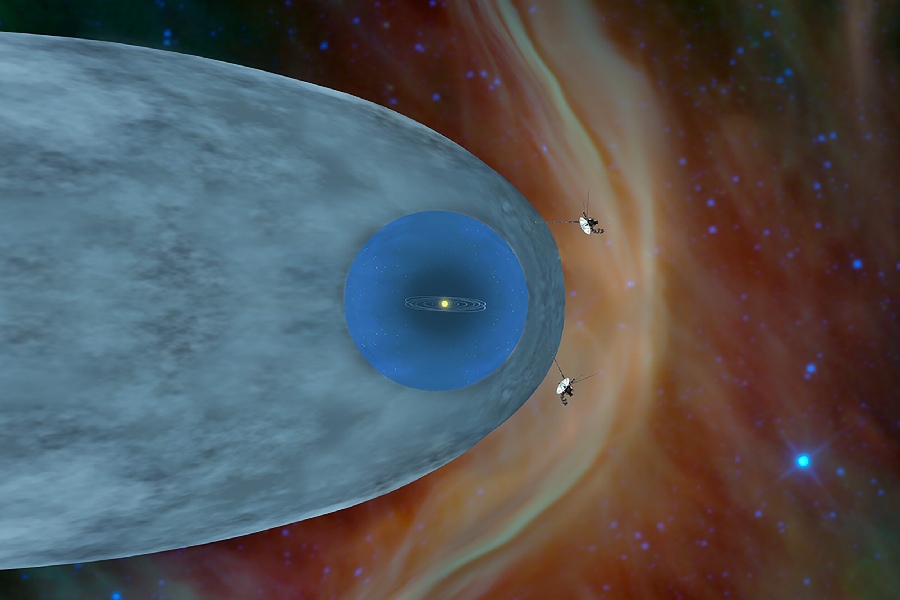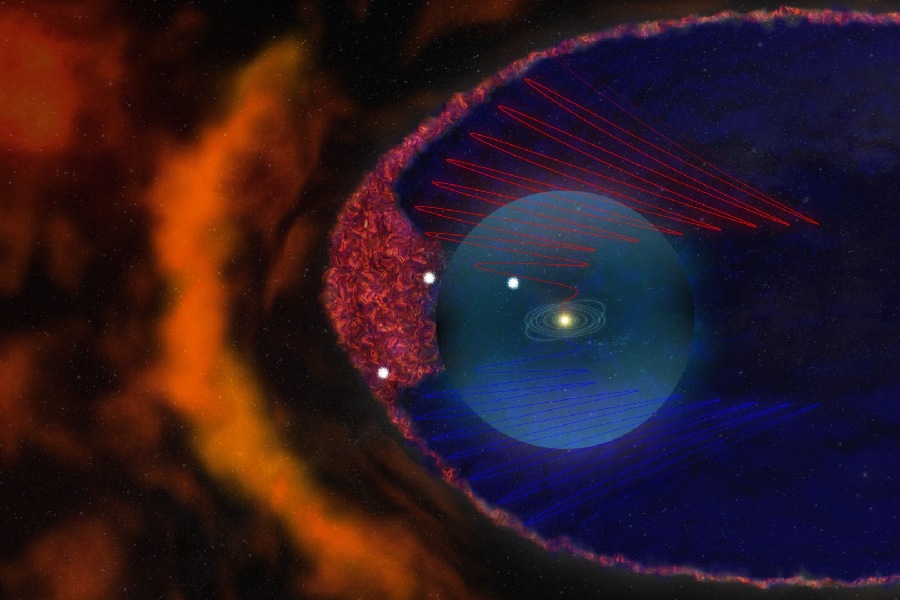As the Sun travels through space, emitting charged particles in all directions, how far does its influence truly reach? The bubble created by the outward pressure of the solar wind and the Sun’s magnetic field is referred to as the heliosphere.
Though invisible, this enormous, spherical structure essentially marks the cosmic reach of our star into the galaxy. The exact boundaries and full span of the heliosphere have fascinated researchers. They aim to map the domain of the Sun in relation to its planetary systems.
How big is the heliosphere? Determining its vast dimensions has been aided by recent interstellar probe missions providing key data on pressure changes in the solar wind. But uncertainties still remain about just how big the heliosphere genuinely spreads.
So what defines the edges of the heliosphere and how do scientists quantify its colossal size? How was evidence gathered to model its shape? Read on for an exploration of how researchers have worked to measure the awe-inspiring extent of the Sun’s influence.

How Big Is the Heliosphere?
How big is the heliosphere? The heliosphere is really big! It’s like a bubble that surrounds our whole Solar System, created by the Sun’s constant stream of particles called the solar wind. This bubble extends far beyond the planets, way past Pluto.
Scientists think it stretches about 100 times farther than the distance from the Sun to Earth. Making it gigantic compared to the size of our Solar System itself. It’s like a protective shield that helps to keep harmful cosmic rays out and holds in the Sun’s magnetic field.
Determining the Size of the Heliosphere
For centuries, astronomers relied on the deflection of comet tails to glimpse the Sun’s influence beyond the known planets. However, the true extent of the heliosphere, the invisible bubble shaped by the Sun’s wind, remained a mystery.
Early estimates, based on the presumed weakening of the solar wind, placed the heliosphere roughly twice the distance of Pluto’s orbit. The dawn of the space age ushered in a new era of exploration. Theoretical models initially suggested a vast heliosphere, stretching to a staggering 40,000 astronomical units (AU).
But as the 1970s arrived, data on space plasma revealed a faster decline in solar wind strength, prompting a downward revision of estimates to less than 100 AU.
The true revelation awaited a daring mission. Launched in 1977, the twin Voyager probes embarked on a secret mission – venturing beyond the familiar Solar System to directly sample the outer reaches of space. Their journey would be instrumental in pinpointing the boundaries of the Sun’s invisible domain, the heliosphere.
Modern techniques, instruments measurement challenges
Specialized probes now sample the solar wind, and magnetic field changes far from Earth. Twin Voyager crafts track transitions in plasma, fields, and cosmic rays along different trajectories outwards. Additional satellite monitoring improves solar wind models and detection of heliopause crossings.
IBEX maps energetic neutral atoms funneling in from the heliosphere’s edges. The heliosphere boundary fluctuations and asymmetry make its true size tricky to pinpoint. Far-flung exploration is costly and still limited in most directions.
Indirect observations require interpretation and assumptions for models. But combining improved models with new probe data continues incrementally revealing the giant, dynamic structure of our heliosphere bubble.
Average distance from Sun to edge
The current best estimate puts the average heliosphere radius at 120 astronomical units (AU). For scale, 120 AU surpasses well over twice Pluto’s average distance from the Sun. One AU is the average Earth-Sun span of 93 million miles – so multiply that by 120.
This signifies a colossal bubble enclosing all the inner planets clear past Neptune’s orbit. Though the precise dimensions still have some uncertainty and vary over time, evidence points to a huge expanse.
Visualizing the immense scale
So, how long is the heliosphere? Our heliosphere stretches more than 12 billion miles wide in average condition when factoring in its teardrop-like tail extending behind. Conceptualizing such extraordinary measurements provides deeper awe for the sheer scale of the Sun’s sphere of influence.
To envision, if the Sun was the size of a grapefruit, on this scale, the heliopause border would be around 300 yards away from that grapefruit. The orbit of Saturn would sit at only eight inches out in this model.
This emphasizes the vast volume our heliosphere occupies in space relative to the planetary distances within it. Truly enormous when put into tangible visualizations at this cosmic scope.
Size compared to other astronomical units
The enormous sweep of the heliosphere becomes clearly evident when contrasted with other known cosmic structures. Our entire Solar System fits within the span of the heliosphere bubble thousands of times over.
The Oort Cloud only reaches out less than a third as far from the Sun as the average heliopause boundary. Jupiter’s magnetosphere pales at extending about seven million miles while our heliosphere stretches beyond 12 billion miles wide.
Grasping the scale through comparisons
The biggest known solar system, a ring of debris surrounding dwarf star Fomalhaut, would not even reach halfway to our heliopause limits based on current data. These giant comparisons make the far-flung size of our stellar neighborhood abundantly clear.
As another interesting comparison showing the scale – Vesta – one of the very largest asteroids residing in our Solar System’s asteroid belt would need over one million copies of itself laid end-to-end to span the diameter of our heliosphere.
Our Milky Way galaxy hosts over 200 billion stars, so imagining each with its own heliosphere bubble yields staggering volume. Evaluating all such analogies proves insightful for grasping the tremendous expanse of our heliosphere commands.

Estimates and Models of the Heliosphere’s Size
Data from Voyager and IBEX craft feed increasing observations that refine heliosphere models. Samples beyond 100 AU out show the solar wind slows and piles up around the contact boundary with interstellar wind flows.
This gives evidence for average radials modeled now at 120 AU or more for the heliosphere radius. The shape displays asymmetry as well. It extends farthest backwards in the downwind direction before the stunted “nose”, where opposing external pressure pushes more directly.
Researchers qualify models over time as new measurements update incoming energetic particle concentrations coming from the edges. However, the models consistently uphold the immense 100+ AU dimensions, with variance in the elongated tail versus the blunted front.
Continued modeling and simulation refinements hinge on adding new time-series tracking of boundary shifts. This promises an ever clearer perspective on the true colossal scale entailed.
Current Understanding of the Heliosphere’s Size
Synthesizing from the latest spacer probe data, modeling efforts now converge confidently on a heliosphere radius averaging at least 120 AU. This exceeds prior assumed extents. However, it aligns with newer external pressure and energetic particle signature evidence from NASA’s historic interstellar missions.
The tailored models also characterize the bubble’s tear-drop asymmetry with a 50 AU-longer tail versus the nose direction facing Solar System travel. Though unknowns linger for the precise dimensions and variability, agreement solidifies around the generalized enormous scale established.
Findings continue refining boundaries and causal factors – like stellar wind strengths versus intervening interstellar medium densities. Upcoming probes will further observe our heliosphere’s responses over time.
The present understanding clearly expands and quantifies some key aspects. These include the far-reaching plasma sheath and magnetic structure encompassing our Sun’s influence through a vast spherical interface. This interface spans out to lengths covering over 10 times farther than Pluto.
Implications and Significance
Grasping the true enormous reach of our Sun’s heliosphere bubble fuels both practical research applications and transcendent perspectives alike. Defining this sphere of influence sets a vital context for solar storm threats to Earth orbits and human ventures beyond.
It also elucidates the tally of comets still trapped in the Sun’s reach versus interstellar comets following hyperbolic paths. Appreciating the limits illuminates humanity’s very place within one miniscule stellar cocoon. This cocoon is among the ocean of stars comprising our home galaxy.
Insights bridging planetary to cosmic scales
Understanding the heliosphere, the Sun’s vast bubble in space, transcends a simple boundary measurement. It acts as a gateway, bridging the gap between our local planetary system and the grander cosmic stage.
By mapping the heliosphere’s scale, we gain insights into the life cycles of other stars. This knowledge helps us trace the patterns of particle flow and stellar evolution across galaxies over eons.
Here, at the turbulent interface where the solar wind meets the interstellar medium, different disciplines converge, revealing a richer tapestry of the universe. This quest to define the heliosphere’s edge echoes the very question that initiated it all – how far does the Sun’s influence truly extend? But the journey inward is equally significant.
By understanding the heliosphere’s colossal scale, we can refine models that simulate billions of years of radiation exposure on the inner planets. This, in turn, sheds light on the evolution of planetary climates and potentially the emergence of life itself.
The heliosphere thus becomes a bridge, connecting the vast astronomical environment with the intimate conditions on our own Solar System’s planets. Its study offers a unified perspective, allowing us to understand both the grand cosmos and the delicate cradle of life on Earth and potentially other worlds.
Conclusion
For centuries, pinpointing the exact extent of the heliosphere – the Sun’s sphere of influence – remained a daunting task. Only recently, with dedicated spacecraft venturing to its predicted edges, have we been able to estimate its true size. It is a gigantic, teardrop-shaped bubble reaching well over 100 AU and encompassing all known planets.
To answer how big is the heliosphere isn’t just about precise boundaries. It reveals the Sun’s profound impact on our galactic neighborhood, shaping particle flows and potentially influencing the life cycles of other stars.
As we continue to unravel the mysteries of this vast bubble, a deeper perspective on the Sun’s influence and its role in the grander cosmos emerges.
